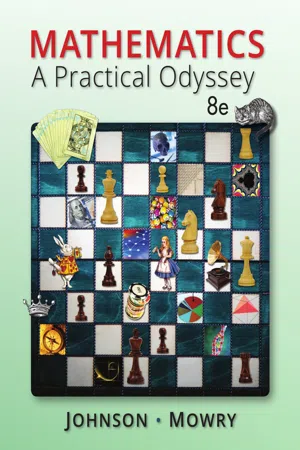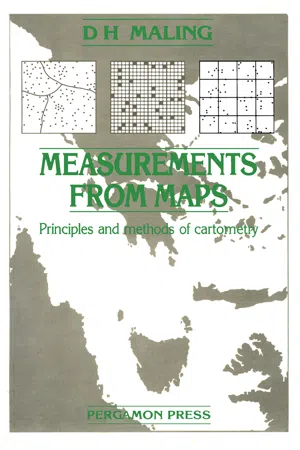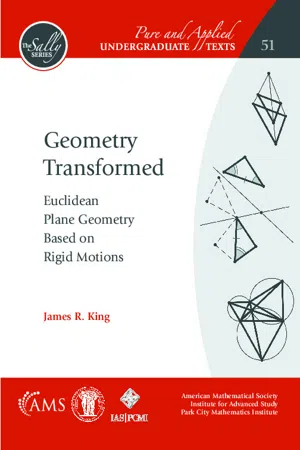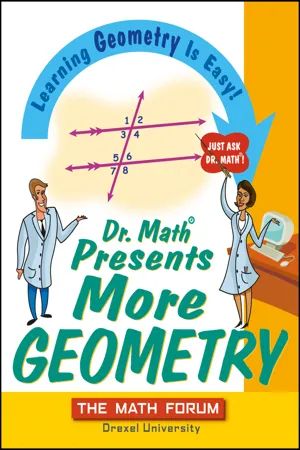Mathematics
Area of Trapezoid
The area of a trapezoid is calculated using the formula A = (1/2)h(b1 + b2), where A represents the area, h is the height, and b1 and b2 are the lengths of the two parallel sides. This formula allows for the quick and accurate determination of the trapezoid's area, making it a valuable tool in geometry and real-world applications.
Written by Perlego with AI-assistance
Related key terms
1 of 5
10 Key excerpts on "Area of Trapezoid"
- eBook - PDF
Mathematics
A Practical Odyssey
- David Johnson, , Thomas Mowry, , David Johnson, Thomas Mowry(Authors)
- 2015(Publication Date)
- Cengage Learning EMEA(Publisher)
(See Figure 8.4.) It is very easy to find the area of a rectangle or square. On the basis of these quadrilaterals, we can also find the areas of triangles, trapezoids, and parallelograms. A trapezoid is a quadrilateral with one pair of parallel sides; a parallelogram is a quadrilateral with two pairs of parallel sides. The area of a triangle, rectangle, parallelogram, or trapezoid can be found by use of the appropriate formula given in Figure 8.5, with A 5 area, b 5 base, h 5 height, and b 1 and b 2 5 bases. (a) triangle A 5 bh. b h 1 2 h b (c) parallelogram A 5 bh. b h (b) rectangle A 5 bh. h (d) trapezoid A 5 ( b 1 1 b 2 ) h. b 2 b 1 1 2 Figure 8.5 Area formulas for common polygons. 5 1 ft 2 1 ft 1 ft Figure 8.4 Woven cloth. Copyright 2016 Cengage Learning. All Rights Reserved. May not be copied, scanned, or duplicated, in whole or in part. Due to electronic rights, some third party content may be suppressed from the eBook and/or eChapter(s). Editorial review has deemed that any suppressed content does not materially affect the overall learning experience. Cengage Learning reserves the right to remove additional content at any time if subsequent rights restrictions require it. 8.1 Perimeter and Area 541 Why does the area of a triangle equal one-half the product of the base times the height? The answer lies in the formula for the area of a rectangle. A triangle can be divided into two smaller triangles. If copies of these smaller triangles are then “added on” to the original triangle, a rectangle of area b · h can be formed, as shown in Figure 8.6. Because the area of the original triangle is half that of the rectangle, we have the desired result. Why does the area of a parallelogram equal the product of the base times the height? Once again, the answer lies in the formula for the area of a rect-angle. A parallelogram can be rearranged to form a rectangle of area b · h , as shown in Figure 8.7. - eBook - PDF
Geometry
A Self-Teaching Guide
- Steve Slavin, Ginny Crisonino(Authors)
- 2004(Publication Date)
- Wiley(Publisher)
A = bh b is the length of the base and h is the height of the triangle. A = 24(10) = 240 The area is 240. h = 10 d = 26 B A C D Perimeter and Area of Two-dimensional Polygons 129 Trapezoids A trapezoid is a quadrilateral having two and only two parallel sides. The legs are its non- parallel sides, the bases are its parallel sides. Example 4: What is the perimeter of the following trapezoid? Solution: P = 9 + 12 + 10 + 22 = 53 The next thing we’re going to tackle is finding the area of a trapezoid. The area of a trapezoid equals one-half the product of its height and the sum of its bases. Area of a trapezoid formula: A = h(b 1 + b 2 ) By convention, b 2 is the longer base and b 1 is the shorter base. As long as we’re given or can solve for the height and both bases, we should have no problem find- ing the area of any trapezoid. Just plug the numbers into the formula and simplify. Example 5: Find the area of the trapezoid in example 4. Solution: A = h(b 1 + b 2 ) Substitute 8 for h, 22 for b 2 and 12 for b 1 . A = (8)(22 + 12) = 4(34) = 136 1 2 1 2 1 2 22 12 8 9 10 b 1 b 2 h 130 GEOMETRY Example 6: The area of the following trapezoid is 8. Find its perimeter. Solution: To find its perimeter, we have to find the sum of all its sides. First we have to find the length of all the sides that aren’t labeled. For reference purposes, let’s call the unknown sides a, b 1 , and c. A = 1 2 h(b 1 + b 2 ) We already know the area and the measure of b 2 . 8 = 1 2 h(b 1 + 10) This equation has two variables (unknowns) in it. We can’t solve for either variable until we find the value for one of them. We don’t have enough information to solve for h, but we do have enough information to solve for b 1 . b 1 = 10 − 3 − 1 = 6. 8 = h(10 + 6) Add the 10 and the 6. 8 = h(16) Multiply times 16. 8 = 8h Divide both sides of the equation by 8. h = 1 Now that we know the measure of h, we can use the Pythagorean theorem to find the measures of sides a and c. - eBook - PDF
- Alberto D. Yazon(Author)
- 2019(Publication Date)
- Society Publishing(Publisher)
4.11.1.1. Perimeter The type of polygon that is nothing but a quadrilateral which is having at least a pair of parallel sides is known as the Trapezoid. Two sides of a trapezium are parallel. The perpendicular distance between the parallel sides is known as the altitude (Figure 4.23). Figure 4.23: Perimeter of a trapezoid. Introduction to Mathematical Literacy 96 The perimeter of a trapezoid formula can be written in the form of: P = a + b + c + d where, a, b, c, d are the lengths of each side. 4.11.2. Area of Trapezoid Trapezium area can be evaluated with the help of the application of the formula which is given below: Area = (1/2) h (AB + CD) Form the above figure, the Trapezium perimeter formula is as follows: Perimeter = Sum of all the sides = AB + BC + CD + DA 4.12. POLYGON A polygon which is having equal sides’ that is equilateral and equal angles that is equiangular is known as a regular polygon. An apothem is applied to determine or evaluate the area of a regular polygon. Apothem is a segment that links or connects the center of the polygon to the midpoint of any of the side, and it is perpendicular with respect to that side (Figure 4.24). Figure 4.24: A block diagram of the polygon. Source: https://live.staticflickr.com/5589/14779107992_ab3475d26b_b.jpg. All of the vertices of a regular polygon lie on a common circle (which is the circumscribed circle), that is they are concyclic points. That is, a regular polygon is a cyclic polygon. Along with it, the property of sides which are having the equal sides, this shows that every of the regular polygon also has an inscribed circle or in circle that is tangent to every side at the midpoint. Perimeter and Area 97 In this way, a regular polygon is a tangential polygon. A regular n-sided polygon can be structured with the help of the compass and straightedge if and only if the odd prime factors of n are distinct Fermat primes. - eBook - PDF
Measurements from Maps
Principles and Methods of Cartometry
- D H Maling(Author)
- 2016(Publication Date)
- Butterworth-Heinemann(Publisher)
Using modern methods of data collection and storage there is no reason why they should not be used to measure the area enclosed by a coastline or other irregular boundary, even if this comprises many hundreds of thousands of separate coordinated points. 328 Measurements from Maps THE AREA FORMULAE OF PLANE GEOMETRY The formulae which follow are presented without proof, for all of them are well known and they are listed here to remind the reader how each of the measurements and calculations are made. The Area of a Triangle Figure 16.1(a) illustrates a triangle ABC in which one side is designated the base, b, and the line perpendicular to it which passes through the opposite vertex is called the height, h. Then, the area, A=b-h (16.1) If any of the angles of the triangle are also known, alternative solutions are A=absinC (16.2) (e) ( f ) FIG. 16.1. Measurement of area of simple plane figures according to the rules of Euclidean geometry: (a) the triangle ABC; (b) the rectangle ABCD; (c) the parallelo-gram ABCD; (d) the rhombus ABCD; (e) the trapezoid, ABCD; (f) any quadrilateral ABCD. Geometrical Methods of Area Measurement 329 (16.3) A =jbc'unA (16.4) For a triangle in which the perpendicular height had not been determined, and the angles have not been measured, but the lengths of all three sides are known, the half-perimeter formula may be used A = y J { s (s-a){s-b)(s-c)} (16.5) where s = ^ a + b + c) (16.6) or is one-half of the length of the perimeter of the figure. The Area of a Rectangle In Fig. 16.1(b) the rectangle ABCD has the sides AB = a and BC = b. Quite simply. A = a-b (16.7) The Area of a Parallelogram In Fig. 16.1(c) the figure has side AB = a and BC = b. Also h is the length of the perpendicular to one pair of the parallel sides. Then A = ah (16.8) Also A = abs'mB (16.9) The Area of a Rhombus The length of each side of the figure is equal to a. - eBook - PDF
- (Author)
- 2015(Publication Date)
- For Dummies(Publisher)
322 Part IV: Applying Algebra and Understanding Geometry Tuning in triangles Finding the area of a triangle can be a bit of a challenge. Basically, a triangle’s area is half that of an imaginary rectangle that the triangle fits into. However, it isn’t always easy or necessary to find the length and width of this hypothetical rectangle — you just need a measurement or two from the triangle. The traditional formula for finding the area of a triangle involves the length of the base, or bottom, and the height, the perpendicular distance from the base up to the vertex (the intersection of the other two sides). Finding the area of a triangle is easy if you can use a ruler to find the height, but that isn’t always practical. So, you have another option — Heron’s formula, covered later in this section. Going the traditional route The area of a triangle is equal to half the product of the measure of the base of the triangle, b, times the height of the triangle, h: A bh 1 2 = . The base is the length of the bottom that the height is drawn down to. The height is the length from the top angle down perpendicular to the base. The height forms a right angle (90 degrees) with the base. Figure 15‐4 shows you a triangle with a height drawn. You use this traditional rule for area when it’s possible to make these measurements — when you can draw the height perpendicular to the base and measure both of them. The following example shows you how to use the best‐known rule first, and a later example finds the same area using Heron’s formula. Find the area of a triangle 21 metres long with a height of 8 metres. Refer to Figure 15‐4 for a sketch of such a triangle. Figure 15-4: Triangles come in all shapes and sizes. - Alan Tussy, Diane Koenig(Authors)
- 2018(Publication Date)
- Cengage Learning EMEA(Publisher)
A trap. 5 1 2 h(b 1 b 2 ) This is the formula for the area of a trapezoid. A trap. 5 1 2 (12)(30 20) Substitute 30 for b 1 , 20 for b 2 , and 12 for h. A trap. 5 1 2 (12)(50) Do the addition within the parentheses. A trap. 5 6(50) Do the first multiplication: 1 2 (12) 5 6. A trap. 5 300 Complete the multiplication. The area of the trapezoid is 300 ft 2 . To find the area of the upper portion of the tent, we proceed as follows. A triangle 5 1 2 bh This is the formula for the area of a triangle. A triangle 5 1 2 (20)(8) Substitute 20 for b and 8 for h. A triangle 5 80 Do the multiplications, working from left to right: 1 2 (20) 5 10 and then 10(8) 5 80. The area of the triangle is 80 ft 2 . To find the total area of one side of the tent, we add: A total 5 A trap. A triangle A total 5 300 ft 2 80 ft 2 A total 5 380 ft 2 The total area of one side of the tent is 380 ft 2 . Find the area of the shaded region shown on the right. Strategy We will subtract the unwanted area of the square from the area of the rectangle. EXAMPLE 12 5 ft 5 ft 15 ft 8 ft WHY The area of the rectangular-shaped shaded figure does not include the square region inside of it. Copyright 2019 Cengage Learning. All Rights Reserved. May not be copied, scanned, or duplicated, in whole or in part. Due to electronic rights, some third party content may be suppressed from the eBook and/or eChapter(s). Editorial review has deemed that any suppressed content does not materially affect the overall learning experience. Cengage Learning reserves the right to remove additional content at any time if subsequent rights restrictions require it. CHAPTER 9 • An Introduction to Geometry 782 Solution A shaded 5 lw 2 s 2 The formula for the area of a rectangle is A 5 lw. The formula for the area of a square is A 5 s 2 . A shaded 5 15(8) 2 5 2 Substitute 15 for the length l and 8 for the width w of the rectangle. Substitute 5 for the length s of a side of the square.- eBook - PDF
Geometry Transformed
Euclidean Plane Geometry Based on Rigid Motions
- James R. King(Author)
- 2021(Publication Date)
- American Mathematical Society(Publisher)
Chapter 9 Area and Its Applications Areas of Triangles and Parallelograms Area, a familiar and useful topic in the real world, is not only an interesting topic in geometry; it also provides an additional tool for understanding geometrical relation-ships. While it is simple in some respects, it is not so simple in others. The simple part includes the familiar formulas for areas of rectangles, triangles, parallelograms, and other basic polygons. The not-so-simple part is expressing a general definition of area and then proving it agrees with the simple formulas but also applies to shapes such as circles and other nonpolygonal shapes. To derive an area formula for circles, limits are involved. This is as far as we will be going in this book. 1 Area should have these properties: • Congruent figures have the same area. • For a square ? of side length 1, the area 𝒜(?) = 1 . • If the set ? 1 contains ? 2 , then 𝒜(? 1 ) ≥ 𝒜(? 2 ) . • If a set ? is the union of a finite number ? 1 , ? 2 , ... , ? 𝑘 of convex polygons and their interiors such that the polygon interiors do not intersect, then 𝒜(?) = 𝒜(? 1 ) + 𝒜(? 2 ) + ⋯ + 𝒜(? 𝑘 ). Squares and the Definition of Area. All our work with area will rely on the areas of squares. Consider how only one definition makes sense. A square of integer side 𝑚 can be divided into 𝑚 2 unit squares of side 1, so the area should be 𝑚 2 . For example, the square on the left of Figure 1 is 9, assuming the small squares have side 1. If the area of a square of side 1 is divided into squares of side length 1/𝑛 , then since there are 𝑛 2 such small squares, the area of the small square should be 1/𝑛 2 . The area of 1 If one investigates really complicated sets in the plane, such as fractals, it turns out that a set may have no area, or it may have more than one value competing to be area. 161 - eBook - PDF
Dr. Math Presents More Geometry
Learning Geometry is Easy! Just Ask Dr. Math
- (Author)
- 2005(Publication Date)
- Jossey-Bass(Publisher)
Note that when a = b, a + b = b + b ____ _____ 2 2 = 2 ⋅ b ____ 2 = b If we make all the angles square, we have a rectangle: 120 Dr. Math Presents More Geometry b a b a area = height ⋅ a + b _____ 2 And the formula still works. If we make the width the same as the height, we have a square: area = height ⋅ a + b _____ 2 And the formula still works! The principal difference is that when you have a rectangle or a square, the height is easy to find, whereas when you have a trapezoid or a parallelogram, the process can be somewhat more involved. So what about a triangle? Well, if we draw the triangle so that the base is horizontal, then the value of the top base a is zero, so the for- mula gives us Quadrilaterals and Other Polygons 121 a b a b a a a b b b area = height ⋅ a + b _____ 2 = height ⋅ 0 + b _____ 2 = 1 ⋅ height ⋅ b _ 2 So it works for a triangle, too—if you’re willing to define a triangle as a quadrilateral with one zero-length side. I hope this helps. Thanks for an interesting question! —Dr. Math, The Math Forum Hi, Quentin, In fact, a rectangle is a special case of a parallelogram in which all the angles happen to be 90 degrees. So you can use the same for- mula to compute the area of each, which is area = base ⋅ height 122 Dr. Math Presents More Geometry Dear Dr. Math, I have a couple of questions. First, when you press on the corners of a rectangle to make a different parallelogram, what happens to the area and perimeter of that figure? Second, what happens when you have a family of parallelograms, with the first one being a rectangle and the others being tilted or extended to the right? The book says the area stays 20 square units, but what about the perimeter? I am really confused about these issues. Yours truly, Quentin Rectangle to Parallel- ogram - eBook - PDF
- John Peterson, Robert Smith(Authors)
- 2019(Publication Date)
- Cengage Learning EMEA(Publisher)
Area of Trapezoid ABCD 5 1 2 DE ( AB 1 DC ) Example 1 What is the area of a trapezoid that has bases of 7.000 inches and 3.800 inches and a height of 4.200 inches? A 5 1 2 (4.200 in.)(7.000 in. 1 3.800 in.) A 5 1 2 (4.200 in.)(10.800 in.) A 5 22.68 sq in. Ans Example 2 The area of a trapezoid is 376.58 square centimeters. The height is 16.25 centimeters, and one base is 35.56 centimeters. Find the other base. Substitute values in the formula for the area of a trapezoid and solve. 376.58 cm 2 5 1 2 (16.25 cm)(35.56 cm 1 b 2 ) 376.58 cm 2 5 8.125 cm (35.56 cm 1 b 2 ) 376.58 cm 2 5 288.925 cm 2 1 8.125 cm( b 2 ) 87.655 cm 2 5 8.125 cm( b 2 ) b 2 < 10.79 cm Ans Example 3 Find the area of the template shown in Figure 59-9. All dimensions are in inches. Express the answer to 1 decimal place. Divide the template into simpler figures. One way is to divide the template into two rectangles and a trapezoid as shown in Figure 59-10. ● ● Find area 1 (rectangle). A 5 4.20 in. 3 2.00 in. A 5 8.40 sq in. ● ● Find area 2 (trapezoid). Height 5 8.30 in. 2 6.50 in. 5 1.80 in. First base 5 6.80 in. Second base 5 2.00 in. A 5 1 2 (1.80 in.)(6.80 in. 1 2.00 in.) A 5 1 2 (1.80 in.)(8.80 in.) A 5 7.92 sq in. ● ● Find area 3 (rectangle). A 5 6.50 in. 3 6.80 in. A 5 44.2 sq in. ● ● Find the total area of template. Total Area 5 8.40 sq in. 1 7.92 sq in. 1 44.2 sq in. Total Area < 60.5 sq in. Ans (rounded) 8.30 6.50 4.20 8.30 6.50 4.20 2.00 6.80 FIGURE 59-9 6.50 1.80 4.20 2.00 1 6.80 2 3 FIGURE 59-10 D C A E B FIGURE 59-8 444 SECTION 6 GEOMETRIC FIGURES: AREAS AND VOLUMES APPLICATION Tooling Up 1. Trace this line segment two times. On one copy construct a perpendicular bisector of the segment. On the other copy divide the segment into three equal segments. 2. Find the length of x . Round the answer to 2 decimal places. x 20 mm DIA 15 mm DIA 10 mm DIA 5 mm DIA 3. What is the diameter of a circle with a circumference of 425.5 cm? Round the answer to 2 decimal places. - No longer available |Learn more
- Tom Bassarear, Meg Moss(Authors)
- 2015(Publication Date)
- Cengage Learning EMEA(Publisher)
All Rights Reserved. May not be copied, scanned, or duplicated, in whole or in part. Due to electronic rights, some third party content may be suppressed from the eBook and/or eChapter(s). Editorial review has deemed that any suppressed content does not materially affect the overall learning experience. Cengage Learning reserves the right to remove additional content at any time if subsequent rights restrictions require it. Unless otherwise noted, all content on this page is © Cengage Learning Section 9.2 Perimeter and Area 529 When we step back and consider, we can see that the height is the radius of the circle. If we look at the base, the length of the base is equivalent to the width of eight sectors, but eight sectors is equivalent to half of the total distance around the circle, or 1 2 of the circumference. Since the circumference is 2 r , then half the circumference is r . The next figure shows this. π r r Therefore, since to find the area of a parallelogram we multiply base 3 height, the area of the figure is A 5 ( r )( r ) 5 r 2 HISTORY We know that the Egyptians and the Babylonians knew not only the formulas for the area of the square and the rectangle, but also the formula for the area of a trapezoid. They knew the formula for finding the area of a right triangle. There were correct and incorrect formulas for the areas of isosceles triangles. For example, there is an example in the Rhind papyrus (from ancient Egypt) of finding the area of an isosceles triangle by finding half the product of the base and the length of one of the equal sides, instead of the altitude. For the circle, the Babylonians developed the formula A 5 C 2 12 and the Egyptians developed the formula A = ( 8 9 d ) 2 . It will be left as an exercise to see how close their formulas were to the actual formula. INVESTIGATION 9.2e A 16-Inch Pizza versus an 8-Inch Pizza Let’s say you are going out to have pizza with several friends.
Index pages curate the most relevant extracts from our library of academic textbooks. They’ve been created using an in-house natural language model (NLM), each adding context and meaning to key research topics.









